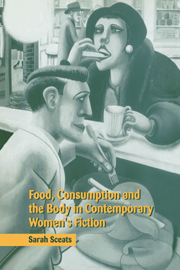Book contents
- Frontmatter
- Contents
- Acknowledgements
- Introduction
- Chapter 1 The food of love: mothering, feeding, eating and desire
- Chapter 2 Cannibalism and Carter: fantasies of omnipotence
- Chapter 3 Eating, starving and the body: Doris Lessing and others
- Chapter 4 Sharp appetites: Margaret Atwood's consuming politics
- Chapter 5 Food and manners: Roberts and Ellis
- Chapter 6 Social eating: identity, communion and difference
- Conclusion
- Notes
- Bibliography
- Index
Chapter 6 - Social eating: identity, communion and difference
Published online by Cambridge University Press: 22 September 2009
- Frontmatter
- Contents
- Acknowledgements
- Introduction
- Chapter 1 The food of love: mothering, feeding, eating and desire
- Chapter 2 Cannibalism and Carter: fantasies of omnipotence
- Chapter 3 Eating, starving and the body: Doris Lessing and others
- Chapter 4 Sharp appetites: Margaret Atwood's consuming politics
- Chapter 5 Food and manners: Roberts and Ellis
- Chapter 6 Social eating: identity, communion and difference
- Conclusion
- Notes
- Bibliography
- Index
Summary
As in the previous chapter, the focus here is on social eating. But while chapter 5 focuses on the literary use of food and manners as signifiers in a social context, this final chapter moves towards a more uncertain, expansive and perhaps challenging view, exploring how eating might be deemed to relate to society as a whole, to social function and to some conception of community. Whether ‘community’ is more than an ideal remains to be seen. How eating is involved depends upon the play of relationships within and between social groups of various sizes, from family, work and friendship clusters to class, ethnicity or society at large.
Given the scale of such a canvas, probably the best way to construct a general or societal perspective is by looking at particular, representative examples of what might constitute social eating. How, for example, do food and eating relate to the identity or cohesion of a certain group and the links between that group and its society? How are food and eating instrumental in the formation of identity in a particular society and what role do they play in socialisation? What is the cultural place of ritual or the social implication of cooking? And are such questions answerable in other than relative terms, given that food and behaviour depend very much on contexts of period, ethnicity, gender, religion, ideology, nationality and cultural systems?
- Type
- Chapter
- Information
- Food, Consumption and the Body in Contemporary Women's Fiction , pp. 155 - 183Publisher: Cambridge University PressPrint publication year: 2000

